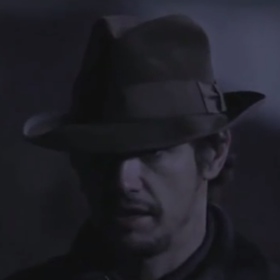'Child Of God' Review: James Franco Directs Scott Haze's Breakout Performance

3.5/5
James Franco has, once again, put himself behind the camera, directing an adaptation of Cormac McCarthy’s Child of God.
The dark drama centers on Lester Ballard (Scott Haze), a rural town’s resident crazy. Aggressive, seemingly insane and proficient with a shotgun, Ballard spent his life in complete isolation after his father committed suicide. He appears more animal than human, as if he had been raised in the woods by wolves – The Wild Child in his twenties. Alone, with no education, no job and no allies, Ballard is an outcast who lives in an abandoned shack in the woods. He has no company, save the chickens and cows he shoots for sport, and, through a strange series of events, ends up in possession of a dead woman’s body. For the first time, Ballard has found a companion, and the scenes between Ballard and the corpse are the only moments in which the audience sees Ballard as a calm, compassionate and sweet human being. He is not angry or forceful with his newfound love, and Ballard’s softer side, as well as Haze’s incredible performance, almost makes you forget the fact that Ballard is a necrophiliac. There is an innocence to Ballard that only manifests itself in these scenes, and the delicacy in Haze’s performance is beautiful. I found myself completely enthralled by Ballard’s made-up love affair, and there were a few times I had to remind myself just how disturbing it was.
Cinematographer Christina Voros, who previously worked with Franco on As I Lay Dying (another Franco-directed picture) and 127 Hours (which starred Franco), presents beautifully composed tableaux in one scene and distractingly frenzied images in the next. Child of God is full of hand-held camera that seems to want to be as shaky as possible. In the opening scene, the camera is so manic – going up and down, stumbling into a close-up of a blurry face, the focus shifting every few seconds – Ballard was impossible to grasp visually. Ballard walks onto a grassy lawn, screaming drunkenly and waving his rifle in the air, and I suspect Franco wanted the camera to reflect his consuming anger. Unfortunately, it doesn’t quite succeed because the audience has not yet glimpsed Ballard, nor are they able to get a good look at him due to the frantic camera movements and focus changes. Without a character or point of view to grab onto, I was left wondering if maybe the entire film would be filmed this way – Blair Witch Project on steroids.
I have not read the book, and so it is impossible for me to say whether or not screenwriters Franco and Vince Jolivette have created a faithful adaptation. However, it is clear that Franco and Jolivette wanted the audience to know that the story is a literary one. The film is sectioned into Chapters, and certain scenes are strung together by a title card and an unknown narrator. I can only assume that the words on these cards, spelled in a large, cursive font, are direct quotes from the book. This is neither good nor bad, though Franco’s heavy use of title cards accompanied by matching voice-over does have an air of self-importance. Franco really wants the audience to know that he has read the book, probably multiple times – and can quote it!
The screenplay did leave a bit to be desired, namely the foundation for Ballard’s character. The film begins with Ballard screaming wildly in front of at least 20 people, and his interactions with Sheriff Fate suggest that Ballard is a well-known troublemaker around town. However, when he goes into town to buy his corpse girlfriend a pretty red dress and panties to match, the salesgirl doesn’t bat an eyelash. Wouldn’t Ballard be known around town as a crazy and dangerous man? Wouldn’t his buying a red dress and panties raise a red flag?
While the script might not be perfect, Franco assembled an impressive cast. In addition to Haze, the film features Tim Blake Nelson as Sheriff Fate, who has fewer scenes and more expository dialogue than he deserves, and an under-utilized Jim Parrack (True Blood) as Deputy Cotton. But, Haze, in particular, is a revelation. I would not give this film a second thought if it weren’t for Haze’s performance – truly one of the best I have ever seen. Haze completely becomes Ballard, and, more importantly, remains consistent throughout. Never once does Ballard’s heavily accented mumbling become clear, and never do Ballard’s awkward and jerky movements flow smoothly.
It’s difficult to pinpoint what, exactly, doesn’t work in Child of God. Is it the dizzying camera, the missing plot points, the lack of character development? I contend that all of these things are problems with the film, but Child of God’s main problem is Franco himself. As a director, Franco allows his actor’s ego to get in the way of making a solid film. Franco appears briefly in the film as Jerry, a member of an angry mob that appears towards the end of the film. While barely any characters in the film – Ballard included – are granted many close-ups, Franco gives himself around five close-ups in no more than five minutes of screen time. It is utterly ridiculous, and only serves to add credence to widely held belief that he is a narcissistic artist – talented, to be sure, but narcissistic all the same.
Should Franco ever read this review, I would implore him not to give himself a bit part in whatever movie he directs next, and might even suggest he direct his next film under a pseudonym. For better or for worse, fair or not, Franco has the somewhat unattractive reputation of forcing his way into any art world, playing on his success as an actor to explore other art forms at a very public level. Not only that, he is also known for being particularly judgmental of those who judge him. He is, essentially, the Kanye West of cinema. Already, audiences are inclined to find Franco’s work a pompous display of faux high art, and his decision to put himself front and center in a pivotal scene of Child of God does little to dispel that belief.
RELATED ARTICLES
Get the most-revealing celebrity conversations with the uInterview podcast!






Leave a comment